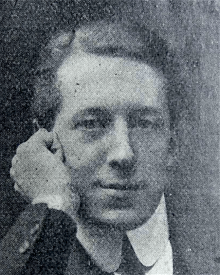
Ralph Knott was born in Chelsea, London, England on 3 May 1878. He was articled to John Henry Townsend Woodd and Wilfred Ainslie of Woodd & Ainslie in London during which time he also attended the Architecural Association Schools. In c.1900 he joined the office of Sir Aston Webb (1849-1930) as an assistant and remained with him for eight years.
Knott came to prominence in 1908 when he won the competition to design London County Hall. That year, in partnership with Douglas Gray Round (1883-1936) as Knott & Round, he also unsuccessfully submitted an entry in a competition to design municipal buildings in Bethnal Green, London. Their designs are illustrated in British Competitions in Architecture vol. 2, no. 15, February 1908 (pp. 116-117). The partnership with Round may have been formed specifically and only for this competition as there is no evidence of their work together after this date.
Following his success in the London County Hall competition, Knott formed a partnership with his cousin, Ernest Stone Collins (1874-1942) as Knott & Collins which had an office in Robert Street, Adelphi, London. Work on the County Hall complex was to absorb much of the time of the practice for the next two decades. Other work by Knott & Collins included a house in Upper Grosvenor Street, Mayfair , London (1908–09); Mallord House, Chelsea, London (completed 1911); a pavilion at the City of London School athletics grounds in Grove Park, London (1925); and two office buildings at Stormont, Belfast.
Knott was elected a Fellow of the Royal Institute of British Architects (FRIBA) in 1921
In addition to his work as an architect, Knott was also an etcher and painter and between 1905-13 exhibited at the Royal Academy in London and at the Royal Scottish Academy in Edinburgh. He died at his home, West Lodge, Christchurch Road, Mortlake, Surrey [now in the London borough of Richmond] on 25 January 1929.
Directory of British Architects 1834-1914. Compiled by Antonia Brodie, et al. Volume 1: A-K. London; New York: British Architectural Library, Royal Institute of British Architects/Continuum, 2001
Gray, A. Stuart. Edwardian architecture: a biographical dictionary. London: Gerald Duckworth & Co., Ltd., 1985
Knott, Ralph and Riley, William Edward. ‘The new London County Hall ... read before the Royal Institute of British Architects ... 22 January 1923’. Royal Institute of British Architects Journal vol. 30, no. 6, 27 January 1923 pp.165-188
Marriott, Charles. Modern English Architecture. London: Chapman & Hall, 1924
‘Obituary’. The Architectural Review vol. 65, March 1929 p. 159
‘Obituary’. The Builder vol. 136, 1 February 1929, 237, 255
‘Obituary’. Royal Institute of British Architects Journal vol. 36, 9 February 1929 p. 296
‘Obituary: Mr. Ralph Knott. The London County Hall’. The Times. 26 January 1929. p. 14.